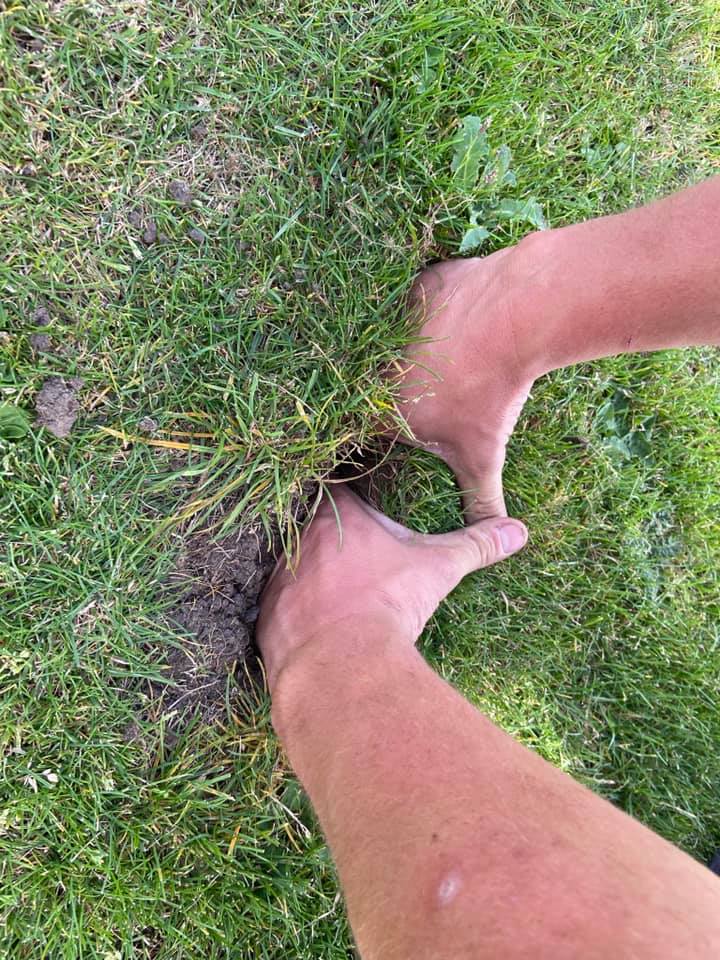Why do cricket pitches crack, is a blog to answer just that, are all cracks bad and what can we do to rectify and prevent cracking in the future.
Why do cricket soils crack?
Cricket loams contain a mix of clay, sand and silt which all are combined to form what we know as a cricket loam dressing.
Clay by nature swells when its wet, i.e., upon wetting via weather or irrigation to a lesser existent. Clay soils when they dry and moisture being held is removed via drying by mean of transpiration or evaporation and to a degree pitch preparation.
A typical UK loam contains between 25-32% of clay, where as somewhere like the waca contain 80% clay, very different climate, grass and soil types would be required to manage such a high clay content.
Soils crack once the soil is depleted of enough moisture to bind/hold the soil particles together, the grass root also needs to be live to assist n this holding process.
A county pitch will commence with play with around 20%-30 soil moisture, moisture is the glue along with the roots that hold/bind together a soil to allow it to have pace and bounce.
Avaible water, evenness/density of the grass canopy and an established root structure are all key elements in holding a cricket pitch together.

Are all Cracks bad?
Shallow surface crack– Can form with very shallow watering and can end up leaving a surface crust, there to be avoided but as a very minor concern.
Circular pattern of cracking– This is often seen on county and international one day pitches, when the pitch needs to be in drier state to remove any chance of seam movement. Often once cracks appear like this at that level the pitch is at its best potential for performing well, as long as those cracks are not too wide or move under the impact of the ball.
Wide and Moving Cracks – These are more commonly found on relatively nearly laid squares, the soil particles have yet to fully interpret, root mass maybe young and consolidation may not have been built up as much as on established pitches.
These types of pitches are hard to manage, you can lose the balance from being ok to too dry very fast, so shorter preparation periods, even grass cover. Even rooting will all assist in helping these types of pitch hold together till they become more established which can take a number of years.
Pitches in this bracket can be variable, the ball can deviate off any wide weak and cracked edges and the ball can become inconsistent if the soil forms a column deep into the profile.
What soils are prone to cracking
- New constructions for 1-5 years depending on clay content, depth and remedial works.
- Cricket squares where they dry out fast and have poor watering facilities and or an unevenly grassed canopy.
- Cricket soils that have been aerated when the soil is at a too dry a state and has opened up. I.e., past the cut off of January.
- Certain loams are more susceptible than other, due to higher shrink and swell rates.

How to Manage a clay soil that has cracked and is causing issues?
Once a soil has deep a crack, to any depth your really up against it, as only rewetting of the profile will swell the soil enough to close them up. Sadly, clay also has a memory, so will remember the lines it opened up, if water reserves in the soil dry out too much. The only way is prevention, by as bullet point out below.
- Keep moisture levels up
- Getting enough moisture in at depth, at the start of preparation.
- The use of wetting agents to help the soil retain and hold moisture.
- The use of covers to prevent excessive drying and or to hold cracks from further opening
- Shorter preparation periods on vulnerable soils.
- Remedial work on newly constructed pitches after use or during renovations, with advice taken from the contractor who built the pitch.

Key things to take from the blog
Not all cracks are bad!
Evenness and grass coverage is key, along with deep established roots.
Moisture management and resources play a massive role.
This is a summary of what l think l know about cracks, we and me are all here to learn so if you have any more knowledge to share, please leave comments in the reply box below.
Brian ,on behalf of the TurfCareBlog community.
Another present issue out there is fairy rings, take a look at this blog on them – https://turfcareblog.com/soil-temperatures-for-fairy-rings-cricket-edition/



2 comments
Brian Sandalls I would say cracks are inevitable with most types of cricket loam in this country unless you keep the soil quite wet but many are so small they are not noticed or are securely anchored by the grass. When they are wide enough so that the ball can bounce variably off them then it may be an issue. This is most likely to happen when there are just a few cracks so each one is quite large. If you have lots of cracks they will be smaller. If the blocks between the cracks are firm and stable again it should be fine but if the blocks move around variable bounce is more likely. Cracking is mainly an issue on new constructions in my experience and as structure develops and organic matter increases in the loam then cracking reduces but so does pace and bounce.
I know a lot of ground staff seed cracks in new pitches and squares by using a fork or spade to create new cracks and thus smaller cracks. Some also dry pitches out and maximise the size of cracks and then fill them with loam, ramming the loam in with chisels and this creates really hard pitches but can push up the edges of the cracks as the soil swells again when it gets wet. Everyone I have spoken to about filling cracks hates it. A job for your juniors from the sound of it. Pretty sure my back could not cope!!
Alex – taken from Facebook
Passed on from our cricket groundsperson Facebook group
Cracks
Cracks in and of themselves are neither good nor bad but simply a result of shrinking soil. Most pitches crack to some extent during drying, though often these cracks may not noticeable. The nature of the soil will determine if/how much it cracks during pitch prep. Cracking should not be the deciding factor in trying to hit peak performance for drying a pitch UNLESS those cracks cause problems. If your cracks tend to mean erratic bounce or affect the ball then clearly peak performance on that pitch is going to be before the soil cracks that much. What constitutes ‘peak’ performance in the real world will depend on how many days play the pitch must sustain, as the pitch will dry over time. If you think of a ‘typical’ test pitch then it will often start with little or no cracking day one as some moisture will have been intentionally left in so that it has ‘somewhere to go’ …then as it dries out further by days 2 and 3, the pitch will get quicker and bouncier and the cracks will open more but it will be good to bat on as the bounce is regular and there is reduced seam movement. Finally, towards the end of the match the pitch will dry more and the cracks may open to the point where the bounce becomes less even and it becomes harder to score (there are plenty of pitches which tend to behave differently to this scenario, as we saw at Trent Bridge last week). For one day pitches, they will generally aim for the ‘day 2 scenario’ since it does not need to last beyond that match…or at least moisture can be applied or adjusted before the next match. If you have such a soil in recreational cricket then the challenge is sustaining quality over the whole weekend or even several weekends…although applying water between use will help.